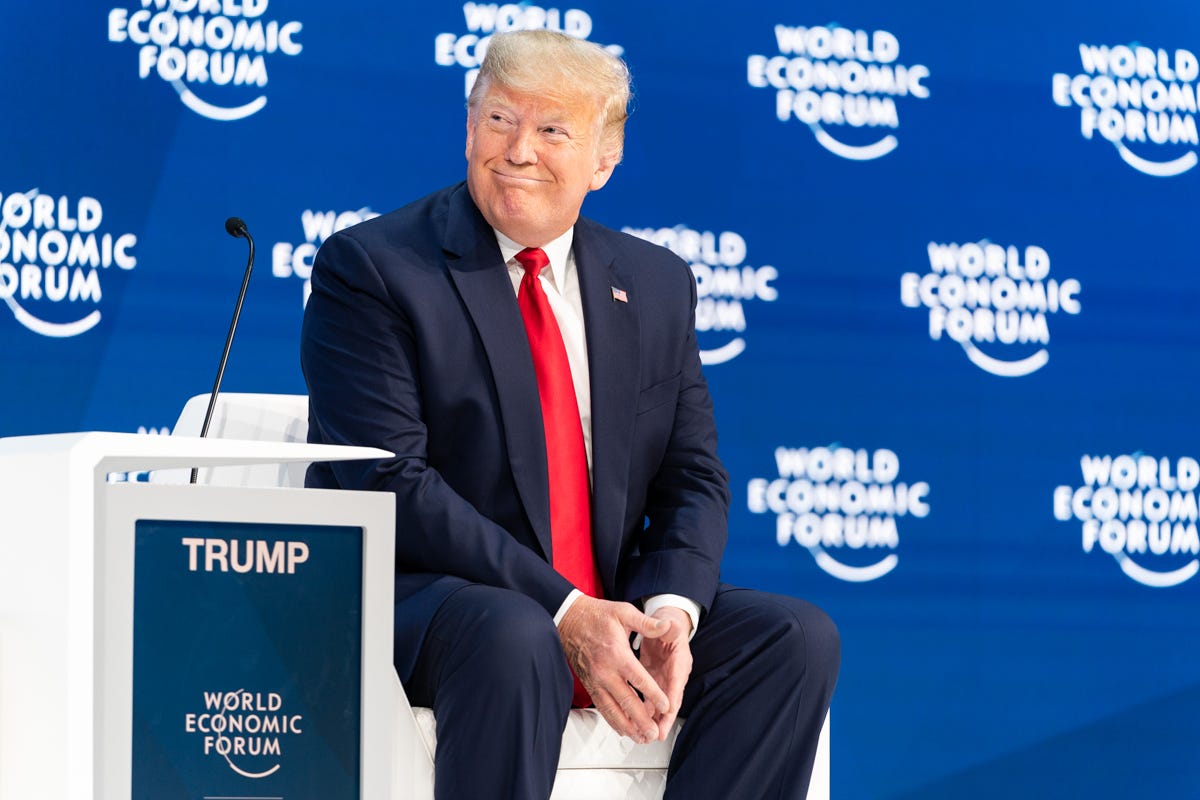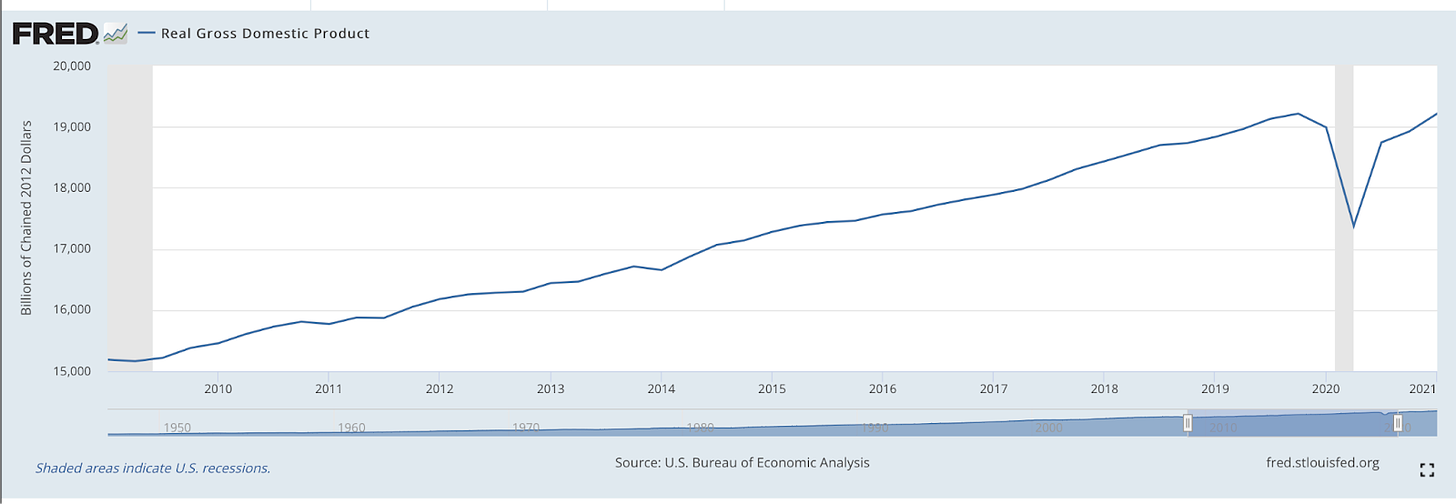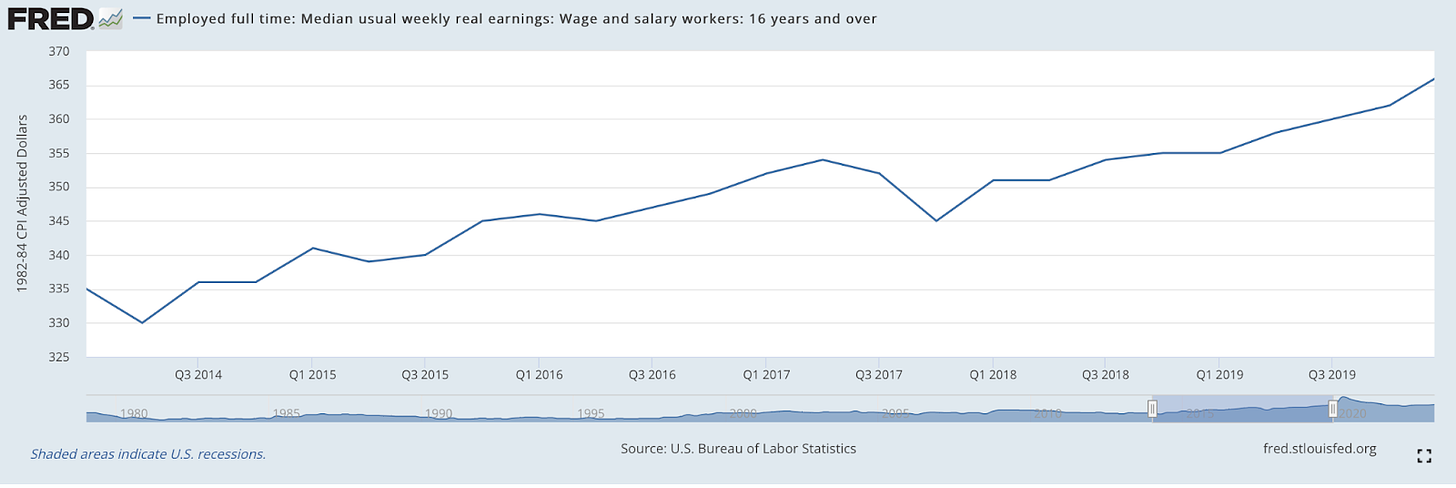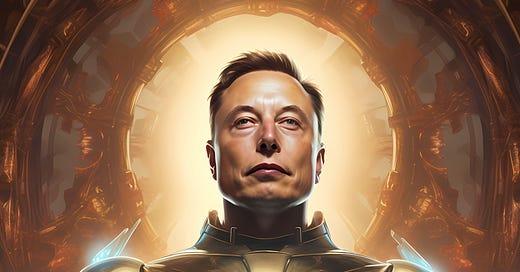
Trump's Economic Performance Wasn't Good
No other president gets a pass on a year of their tenure, but even giving Trump one for 2020 shows his contribution to the US economy was, at best, mediocre
By the standards of every previous president, Donald Trump’s economic stewardship was terrible. America had fewer jobs on his last day than his first. He inherited a growing economy, and left one in crisis.
But in public discussion of the economy, COVID usually doesn’t count. (At least not for Trump in 2020. Few give Joe Biden a pass for the pandemic economy of 2021.)
Trump deserves a break for COVID, but not for his response to it. He boosted vaccine development, which benefited the economy in the longer term, but the first doses were administered December 2020. For the last year of Trump’s presidency, more competent leadership likely would’ve lessened the economic damage.
Instead of denying the problem for months, and later suggesting in a press conference that people ingest disinfectant, he could have increased production and distribution of personal protective equipment. Or organized a national plan to safely open schools.
That’s one reason the right demonizes leading public health official Anthony Fauci, and blames “lockdowns” on Democrats, even though those happened in every state, under governors of both parties, and while Trump was president. It helps sell the idea that anything bad in 2020, including the economy, is something that happened to Donald Trump, and none of it was his fault.
But sure, let’s make this the first time we accept a president’s “events happened” excuse. And we’ll pay no mind to how George W. Bush and Barack Obama both warned about the threat of pandemics and increased the government’s capacity to preempt and fight them, while Trump decreased it. With that, let’s say the Trump economy goes 2017-2019, and his last year in office doesn’t count.
It’s still nothing special.
The Trump Economy (Not Counting Year 4)
Here’s Real GDP since the end of the 2008-09 Great Recession:
You can easily see the COVID crash on the right. But do you see the part before then, around when Trump takes office, where growth leaps up?
No? That’s because there isn’t any. The economy under Trump was mostly on trend from the Obama economy.
GDP growth in Trump’s first three years averaged 2.47%, compared to the average of 2.23% for Obama’s last three. Job growth averaged 177,000 per month in Trump’s first three years, compared to 233,000 the three years prior.
Trump signed one big piece of economic legislation: $2.3 trillion in tax cuts, passed in December 2017, with most benefits accruing to large corporations and wealthy individuals. Additionally, the 2018 and 2019 budgets, passed by Speaker of the House Paul Ryan, increased spending by hundreds of billions. It made for a big, debt-financed stimulus, creating the largest deficit in US history without a recession or major war.
With Trump’s record borrowing, the US economy merely stayed on trend. A report by the nonpartisan Congressional Research Service concluded that the tax cuts had minimal short-term effect on growth.
Wages and salaries did about the same in Trump’s first three years as Obama’s last three. For workers, the two years after the tax cuts looked like the Obama economy.
One thing that did better under Trump was the stock market. That helps some people more than others, but benefits are fairly widespread. About 61% of Americans own stock, many via pension funds and 401(k)s.
Business investment, however, didn’t grow by much. In the first three quarters after the tax cuts passed, companies spent $583.4 billion on stock buybacks, an increase of 52.6% over the previous year, while aggregate capital investment increased 8.8%.
Trump’s stimulus was poorly timed, coming at the top of a macroeconomic cycle. It unsurprisingly did little to boost GDP growth, employment, business investment, or wages, and whatever national benefit it did create was outweighed by blowing a hole in the federal budget when we should’ve been paying down debt, or otherwise preparing for an inevitable crisis.
When a crisis hit in 2020, the federal government spent about $3 trillion to fight it.
The problem was not that the US did debt-financed stimulus in response to COVID. People can debate the details, but in general, the crisis response delivered economic and human benefits, mitigating avoidable suffering. The problem was starting deep in the red, because Trump and the Republican Congress had already done a big (and poorly-designed) stimulus when the economy didn’t need one, delivering little bang for the buck.
Additionally, as was known at the time but is glaring in hindsight, the US economy was already being stimulated by an extraordinary long period of low interest rates. That meant corporations and wealthy individuals (plus some not-so-wealthy ones) already had easy access to capital for just about any business investment they could think of; so much so that the era is marked by companies losing money in pursuit of expansion. As the Atlantic’s Derek Thompson explains, nearly-free loans subsidized the growth of ride-sharing (eg Uber), streaming television (Netflix, Disney+, etc.), and more.
Unsurprisingly, giving money to companies and investors that already had as much as they knew what to do with didn’t do much for economic growth, but did goose the stock market. And it likely contributed to the cryptocurrency and NFT bubble, which burst in 2022.
Trump’s other significant contribution to macroeconomic policy was the trade war with China. The tariffs he imposed—without Congress, under a stretched reading of emergency powers—and China’s retaliations cost the United States 0.25% of GDP and 195,000 jobs, according to Tax Foundation estimates. Trump’s taxes on imports added an estimated $73.9 billion in new revenue, a drop in the bucket of the deficits he created. And much of the tariff revenue went to subsidizing farmers, who lost their biggest foreign market.
Heading into 2024
No matter what anyone thinks of the Biden economy, nor how they vote next year, the first three years of the Trump economy were just okay. Not terrible, but not great either. Mostly a continuation of the okay-not-great economy of Obama’s second term.
Presidents have limited influence over the economy, and get too much credit/blame for economic circumstances. But to the extent Trump contributed, it was net negative.
He shifted some of the tax burden from income to consumption, and from the rich to the middle and working class. He borrowed trillions for little-to-no economic gain, inflating bubbles and increasing inequality, all while putting the country in a weaker position to counteract the problems that popped up later.
Even when we lower the presidential bar and ignore everything in his final year, Trump’s economic record isn’t good.


















I'll never forget Bob Corker insisting that the Tax Cuts and Jobs Act wasn't going to add a single penny to the deficit. It was one of the wildest things I'd ever heard. Right up there with Trump insisting the sun was shining during his inaugural when we all saw the rain. To my knowledge, no one has ever gone back and asked him if he still thinks the tax cuts didn't add to the deficit. I'm not even sure why I think it's important to get his answer, but it feels important.
I wish I could get some of the Trumpers in my family to read this. I keep hearing the economy was great under Trump and now it's terrible. No sources for these opinions, just belief.